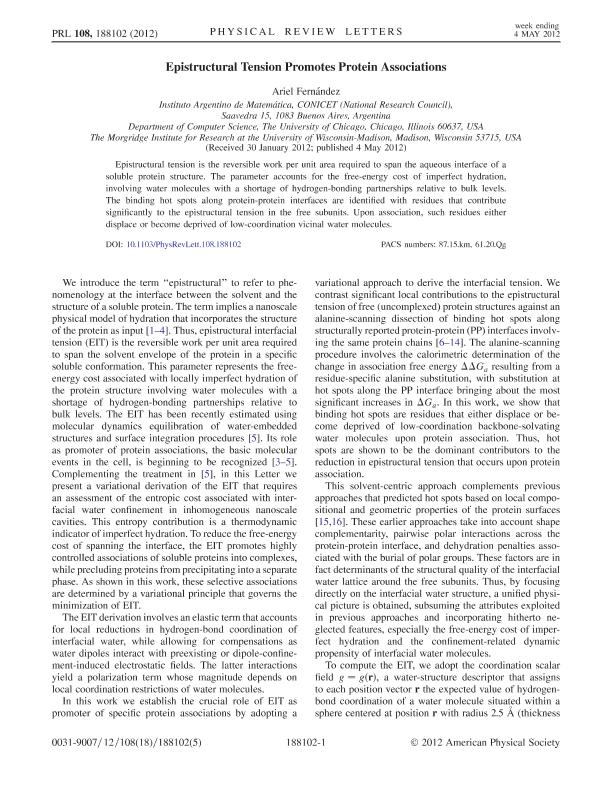Mostrar el registro sencillo del ítem
dc.contributor.author
Fernandez, Ariel

dc.date.available
2017-06-09T20:05:18Z
dc.date.issued
2012-05
dc.identifier.citation
Fernandez, Ariel; Epistructural tension promotes protein associations; American Physical Society; Physical Review Letters; 108; 5-2012; 188102-188102
dc.identifier.issn
0031-9007
dc.identifier.uri
http://hdl.handle.net/11336/17929
dc.description.abstract
Epistructural tension is the reversible work per unit area required to span the aqueous interface of a soluble protein structure. The parameter accounts for the free-energy cost of imperfect hydration, involving water molecules with a shortage of hydrogen bonding partnerships relative to bulk levels. The binding hot spots along protein-protein interfaces are identified with residues that contribute significantly to the epistructural tension in the free subunits. Upon association, such residues either displace or become deprived of low-coordination vicinal water molecules.
dc.format
application/pdf
dc.language.iso
eng
dc.publisher
American Physical Society

dc.rights
info:eu-repo/semantics/openAccess
dc.rights.uri
https://creativecommons.org/licenses/by/2.5/ar/
dc.subject
Biophysics
dc.subject
Biological Interface
dc.subject.classification
Matemática Aplicada

dc.subject.classification
Matemáticas

dc.subject.classification
CIENCIAS NATURALES Y EXACTAS

dc.title
Epistructural tension promotes protein associations
dc.type
info:eu-repo/semantics/article
dc.type
info:ar-repo/semantics/artículo
dc.type
info:eu-repo/semantics/publishedVersion
dc.date.updated
2017-05-15T17:57:19Z
dc.journal.volume
108
dc.journal.pagination
188102-188102
dc.journal.pais
Estados Unidos

dc.journal.ciudad
Maryland
dc.description.fil
Fil: Fernandez, Ariel. Consejo Nacional de Investigaciones Científicas y Técnicas. Oficina de Coordinación Administrativa Saavedra 15. Instituto Argentino de Matemática Alberto Calderon; Argentina. University of Wisconsin; Estados Unidos. University of Chicago; Estados Unidos
dc.journal.title
Physical Review Letters

dc.relation.alternativeid
info:eu-repo/semantics/altIdentifier/url/http://prl.aps.org/abstract/PRL/v108/i18/e188102
dc.relation.alternativeid
info:eu-repo/semantics/altIdentifier/doi/http://dx.doi.org/10.1103/PhysRevLett.108.188102
Archivos asociados
